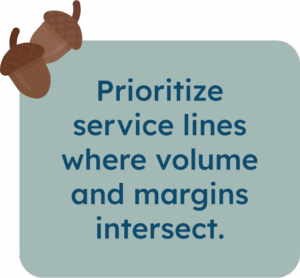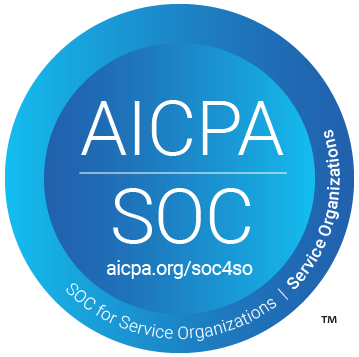Healthcare finance teams spend countless hours analyzing service line profitability. They track supply costs for radiology. Measure nursing hours per patient day in med-surg. Scrutinize lab test volumes and emergency department throughput. Every month brings another report showing which departments are over or under budget.
This department-focused approach to financial management made sense decades ago when hospitals were collections of relatively independent units, but it doesn’t make sense anymore. Still, most healthcare organizations operate as if analyzing departments will somehow reveal the path to sustainable profitability. It won’t.
The reason has nothing to do with the quality of the analysis or the sophistication of the cost accounting systems. The problem is that departments don’t generate patient relationships—service lines do. And service lines don’t exist within neat departmental boundaries.
The Reality Most Finance Teams Ignore
When a patient needs orthopedic surgery, their journey touches a dozen departments. Pre-operative consultation happens in an outpatient clinic. Surgery occurs in the OR. Recovery happens in a dedicated unit. Physical therapy takes place in yet another department. Imaging studies get performed in radiology. Lab work gets processed in pathology. Follow-up visits return to outpatient offices.
Traditional department-level financial analysis treats each of these touchpoints as separate events to be optimized independently. It asks whether radiology is profitable, whether the OR is running efficiently, and whether physical therapy is hitting its productivity targets. These are reasonable questions, but they miss the main point: did the entire orthopedic service line generate acceptable returns for the organization?
Research on rural hospital service lines found that adding or removing most services did not have statistically significant impacts on hospital operating margins, suggesting that service line changes alone rarely drive meaningful financial improvements without understanding the full patient journey and downstream implications.
A hospital might discover through department-level analysis that its physical therapy unit loses money. The instinct would likely be to cut PT services or reduce staffing. But if physical therapy is essential to successful orthopedic outcomes, and orthopedic surgery is a high-margin service line, cutting PT might save $200,000 in department costs while destroying $2 million in surgical volume as patients go elsewhere for comprehensive care.
This is the analytical trap this financial outlook creates. You optimize pieces without understanding the whole. You make decisions that look financially sound at the unit level but undermine profitability at the organizational level.
Why This Matters More Now Than Ever
The financial pressures facing healthcare organizations in 2025 make this analytical blind spot more dangerous than it’s ever been. Labor costs accounted for 56% of total hospital expenses in 2024, the single largest category of spending. Medicare reimbursed just 83 cents for every dollar hospitals spent caring for patients in 2023, creating structural losses that must be covered by higher-margin services.
When your largest payer systematically reimburses below cost, profitability becomes entirely dependent on your ability to attract and retain patients who need services where reimbursement exceeds expenses. That requires understanding which service lines actually generate sustainable margins and making strategic decisions about where to invest limited resources.
Department-level analysis can’t answer these questions because profitable service lines often include unprofitable departments, while unprofitable service lines sometimes include departments that look solid when analyzed in isolation. The emergency department frequently operates at break-even or loss when examined as a standalone unit, yet it serves as the critical entry point for countless profitable admissions across multiple service lines.
The Data Most Organizations Are Missing
Service line profitability analysis requires connecting data that lives in different systems and gets reported to different stakeholders. Patient acquisition costs sit in marketing dashboards. Clinical outcomes live in quality reporting systems. Revenue data exists in the revenue cycle platform. Cost information comes from the general ledger. Payer mix gets tracked separately. Patient satisfaction scores exist in yet another database.
Most healthcare organizations lack the infrastructure to integrate this data in ways that reveal true service line economics. They know how much the orthopedic department spent last month, but they can’t tell you the actual cost to acquire an orthopedic patient, the lifetime value of that patient relationship, including downstream referrals and repeat visits, or whether the marketing dollars spent attracting orthopedic patients generate acceptable returns.
This creates a feedback loop where resource allocation decisions get made using incomplete information, which leads to suboptimal results, which creates pressure to cut costs, which triggers more analysis of department-level spending, which leads to more resource allocation decisions based on incomplete information.
The organizations breaking out of this cycle are those building service line profitability frameworks that connect patient acquisition, clinical delivery, and financial outcomes. They can answer questions like: which service lines generate patients who stay with the organization for years, versus those who disappear after a single encounter? Which acquisition channels bring in patients who need high-margin services versus low-margin ones? Where do marketing dollars generate the highest return when you account for full patient lifetime value?
Why Most Organizations Struggle to Make The Shift
The barrier to service line profitability analysis isn’t conceptual. Most healthcare finance leaders understand that service lines matter more than departments. The challenge is operational and technical.
Shifting from department-focused to service line-focused financial management requires new data infrastructure, different reporting cadences, and changes to how performance gets measured and communicated throughout the organization. Department heads are evaluated based on department-level metrics. Marketing teams get measured on lead generation and cost per acquisition without visibility into whether those leads become profitable long-term patients. Clinical leaders focus on quality metrics that may not connect to financial sustainability.
Building service line profitability frameworks means breaking down silos that have existed for decades. Marketing needs access to patient lifetime value data. Finance needs to understand patient acquisition costs by channel. Clinical operations need visibility into how quality and patient experience affect retention and downstream referrals. Leadership needs integrated dashboards that show the full picture rather than departmental snapshots.
For many organizations, this feels overwhelming when margins are already thin and resources are constrained. The instinct is to keep doing what you’ve always done, which is understandable but ultimately self-defeating. The organizations that will thrive over the next five years are those making the shift now, even when it’s difficult and feels risky.
 What This Actually Looks Like in Practice
What This Actually Looks Like in Practice
Service line profitability analysis doesn’t require abandoning department-level financial tracking. It requires adding a layer that connects departmental performance to patient-level outcomes and organizational financial health.
Start by identifying your organization’s most strategically important service lines. These are typically the areas where patient volume is substantial, reimbursement exceeds costs, and your organization has clinical capabilities that create a competitive advantage. For most hospitals, this includes orthopedics, cardiology, oncology, and certain surgical specialties.
For each priority service line, build integrated profitability models that track patient acquisition costs, clinical delivery expenses across all departments that touch those patients, revenue by payer type, patient retention rates, and downstream referral patterns. The goal is understanding the full economic picture from first patient contact through years of ongoing relationship.
This reveals opportunities that department-focused analysis misses entirely. You might discover that certain acquisition channels generate orthopedic patients who stay with your organization for multiple procedures over years, while other channels bring one-time patients who never return. That insight should completely change how marketing budgets get allocated, but you can’t see it without service line-level analysis.
The Competitive Advantage This Creates
Hospital operating margins have surged 74% since 2022, but that improvement is distributed extremely unevenly. Hospitals with more than 500 beds saw operating margins up 119% since 2022, while smaller hospitals struggled. Part of that gap reflects scale advantages and market power, but it also reflects analytical sophistication.
Large health systems have the resources to build service line profitability frameworks that smaller organizations lack. They can invest in data infrastructure and analytics capabilities that reveal which service lines drive sustainable financial performance and which don’t. That knowledge compounds over time as they double down on profitable service lines while competitors continue making decisions based on department-level analysis.
But analytical sophistication isn’t determined purely by size. Mid-sized and smaller organizations can build service line profitability capabilities by focusing on their most strategic service lines first rather than trying to analyze everything simultaneously. Start with the two or three service lines that represent the biggest volume or the highest margins. Then, build integrated profitability models for those areas and use the insights to make better resource allocation decisions.
Organizations doing this make entirely different strategic decisions than those operating with only department-level financial data. They shift resources toward proven profitable growth rather than spreading investments evenly. They can justify marketing and patient engagement spending that looks expensive at first glance but generates exceptional returns when full patient lifetime value is considered.
The Tools That Make This Possible
Building service line profitability frameworks requires connecting data that traditionally lives in separate systems. Patient acquisition and marketing performance data needs to link to clinical encounter information, which connects to revenue cycle outcomes, which tie back to payer mix and reimbursement patterns.
Some organizations are building custom integrations between their various systems to create this unified view. Others are adopting comprehensive platforms designed specifically for this deeper, more meaningful analysis.
Predictive patient targeting capabilities enhance this framework by helping organizations focus acquisition efforts on individuals most likely to need high-value services. Rather than spending marketing dollars broadly and hoping to attract patients, predictive models identify prospects with the highest probability of needing specific services and reach them before they’re actively searching for care. This improves patient acquisition efficiency while simultaneously improving patient mix toward higher-margin service lines.
ROI tracking systems complete the picture by measuring actual financial outcomes from marketing investments at the service line level. Instead of tracking marketing success through vanity metrics like impressions and click-through rates, organizations can see which campaigns generate patients who become profitable long-term relationships. That visibility allows continuous optimization toward channels and tactics that actually drive sustainable financial performance.
 The Path Forward
The Path Forward
Department-level financial analysis will always have a place in healthcare finance. Understanding costs and productivity at the unit level remains important for operational management. But strategic decisions about where to invest, which service lines to grow, and how to allocate marketing resources require service line-level visibility into patient acquisition costs, lifetime value, and profitability.
Most healthcare organizations know intuitively that service lines matter more than departments. They talk about service line strategy in planning meetings and strategic planning sessions. But when it comes to actual financial analysis and resource allocation decisions, they revert to department-level data because that’s what their systems produce and their processes are built around.
The financial pressures squeezing healthcare aren’t going away. Medicare will continue underpaying. Labor costs will keep rising. Margins will stay thin. In that environment, the organizations that thrive will be those that know what actually drives profitable growth. Department-level analysis won’t get you there. Service line optimization will.











